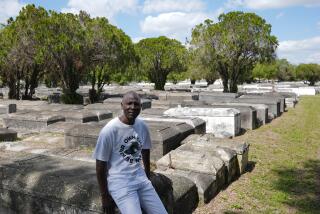A Quest by a Dream Team to Bring Pocahontas Home
- Share via
He has cracked the toughest cases in Connecticut, probed mass graves in Bosnia, was a star in the O.J. Simpson trial. Now Henry Lee is on what may be his strangest mission yet: finding the grave of a long-dead Indian princess at the behest of a Las Vegas crooner.
Pocahontas, the legendary princess who befriended the Jamestown colonists, was buried in an English graveyard 383 years ago, but the location of her remains was lost over the centuries. Now, prompted by entertainer Wayne Newton, Lee has organized a “dream team” of forensic scientists to find her.
Lee, a world-renowned forensic scientist and Connecticut’s Public Safety Commissioner, was recruited by Newton last year. Newton, whose Native American ancestry includes Pocahontas’ Powhatan tribe, showed up in Lee’s office one day to plead for his help in a longtime quest to find and return her remains to her native Virginia.
Lee dismissed Newton’s request at first but was soon won over.
“His sincerity in wanting to bring her back here to close a piece of American history touched me,” Lee said. Newton, who could not be reached for comment, has called Pocahontas’ burial abroad an “atrocity.”
So Lee enlisted New York pathologist Michael Baden and English coroner Peter Dean, who often works with Scotland Yard. The scientists are not being paid, although Newton is covering expenses. He also agreed to perform for free at this year’s annual American Academy of Forensic Science conference.
The trio visited St. George’s Church in Gravesend, England, several months ago to tour the grounds and look at some historical data.
“This is a long-term project and not something that is going to happen right away,” Lee said. “We’ve just touched the surface of this.”
The problem, Lee said, is Pocahontas’ bones could have been moved twice since her original burial.
Gravesend residents don’t seem to share Newton’s passion or Lee’s scientific curiosity for finding Pocahontas’ remains.
“We don’t normally go looking for remains of folks buried for more than 350 years,” said David Willey, the current rector at St. George’s Church. “She’s in glory with God no matter where her bones are buried.”
Pocahontas was the daughter of Powhatan, a powerful chief who led several tribes in the area of what is now Virginia where the Jamestown colonists settled in 1607. According to the legend recounted in the Disney movie--and discounted by many historians--she saved the life of Capt. John Smith after his capture by an Indian hunting party.
She maintained sporadic contact with the colony over the next several years but in 1613 was captured and held as ransom for some English prisoners taken by Powhatan. The next year she converted to Christianity, took the name Rebecca and married colonist John Rolfe.
In 1616, the Rolfes traveled to England, where they were introduced at court. Pocahontas became ill with a respiratory disease as they boarded ship for America. The ship was forced to dock at Gravesend, a London suburb, where Pocahontas was buried at St. George’s.
The original burial registry indicates she was interred on March 17, 1617, in a vault beneath the chancellery of the church.
The church burned in 1727, and a new one was built on the site. During construction, several graves were opened and the remains reinterred in the church courtyard.
There is no record indicating which graves from the hundreds on the site were moved. Many of those same graves were moved again in 1890 when an addition was built to the church.
“We aren’t sure where her bones are,” said Gravesend Chamber of Commerce Director Graham Sawell. “We believe they may be underneath the church, but without digging up the whole thing, they’ll never find them.”
In 1923, a group of Americans known as the Pocahontas Memorial Assn. got permission from England’s Ministry of Home Affairs to do some digging. The search proved fruitless.
But with gains made in forensic science, Newton believes there’s a better chance of tracking down the princess’ bones.
Identifying her remains among the thousands of displaced bones would not be easy, Baden said, but it’s not impossible.
First, Pocahontas’ skull would have different features than those of English adults buried at Gravesend. Then, to verify that the bones actually are Pocahontas’, they would perform DNA tests using samples from some of her descendants, Baden said. But before Lee and his team try to dig for Pocahontas’ remains, they will need approval from the church. And that isn’t likely.
“We would resist strongly, because there are remains of other people in Gravesend here, and I don’t think there would be any justification for digging them up,” Willey said.
While they don’t know where Pocahontas’ remains are buried, the British did erect a statue of her on the church grounds in the 1950s. The Disney animated hit movie released in 1995 has brought more visitors to St. George’s.
One person who has not visited is Newton.
“If he comes here, he’ll get a warm welcome,” Willey said. “Just as long as he doesn’t bring a shovel with him.”
More to Read
Sign up for Essential California
The most important California stories and recommendations in your inbox every morning.
You may occasionally receive promotional content from the Los Angeles Times.













